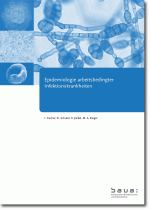Epidemiology of work-related infectious diseases
(in German)
Risk assessment according to ArbSchG (German Occupational Health and Safety Act) requires also (among other things) to investigate whether a risk of infection exists for the employee. Relevant information is presented in the German Ordinance on Biological Agents (BioStoffV), as well as in the more specific technical rules for work with biological agents (TRBA). However, these technical rules as well as the documents given by the federal states (Länder) and the statuary health insurance organisations do not cover all exposure scenarios. Generally, sufficient information can be found concerning activities with biological agents in laboratories and the related area of biotechnology. In addition, information material exists for occupational health hazards affecting large numbers of employees or for obvious potential health risks (e.g. health services, waste management, and agricultural work). In contrast, this information is often missing for less common occupations or causes of infectious diseases. It is especially lacking in regard to possible occupationally related increased risks of infection from non specific exposure to biological agents outside of laboratories.
Accordingly, literature research and evaluation of the project was focused on this problem. First a group of interesting bacteria, viruses, fungi, and parasites were selected from the list of infectious organisms in appendix 3 of the Directive 2000/54/EC. This was followed by a standardised literature search in international databanks. In addition, official national and international publications were evaluated. The results of the literature research were compiled according to the number of usable references into agent-specific short or long reports. For some of the agents for which there were already very numerous publications concerning the epidemiology of occupationally related infections, no reports were drawn up (e.g. Hepatitis B virus).
Literature research was carried out for 256 infectious organisms. From the combination of case studies and epidemiologic data, 17 organisms were selected for further consideration in the sense that research projects appeared to be indicated.
The applied procedure was able to expose previously unknown occupationally related infection risks for selected occupations or expositional scenarios. The data base for infection risks already known could be expanded.
Hence, the results of the project provide an important basis for health hazard evaluation and risk assessment of work activities involving possible risk of infection. In the single occupational setting, depending on the factors influencing the individual risk of infection, the results of the risk assessment may deviate from the results of this literature research.
Please download the complete report "Epidemiology of work-related infectious diseases" (in German only).
Bibliographic information
Title: Epidemiologie arbeitsbedingter Infektionskrankheiten. FH500/29
1. edition. Dortmund: Bundesanstalt für Arbeitsschutz und Arbeitsmedizin, 2013. pages: 425, Project number: F 5198/A91, PDF file
